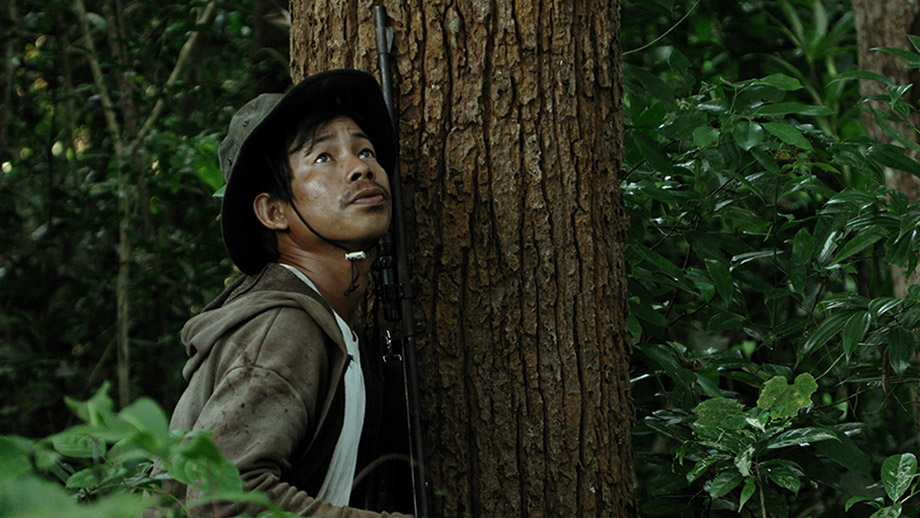Rithy Panh can credibly hold the title of both Cambodia’s most important film director and one of the greatest documentarians alive. A survivor of the brutal Khmer Rouge regime that claimed the lives of his family members, he began studying filmmaking in France before returning to his native country in the late 1980s. His nonfiction output largely focuses on the aftermath of the Cambodian genocide and moves fluidly between brutally direct vérité (“S21: The Khmer Rouge Killing Machine,” 2003), archival material (“Irradiated,” 2020) and, in the case of the his most celebrated film “The Missing Picture” (2013), claymation. With his most recent film, “We Are the Fruits of the Forest,” Panh opts for a more restrained but still incisive approach to the plight of a specific group of downtrodden people in his nation’s present.
After a brief drone shot over the trees, “We Are the Fruits of the Forest” begins with Panh’s main recurring formal gambit for this particular project: a split screen presentation of silent black-and-white archival footage. The subject in both that found material and his film at large is the Bunong people, an indigenous ethnic group living in the highlands of northeastern Cambodia. Historically, they have grown large-grain rice in mountain forests, clearing sections of trees to create fields according to their ancestral ceremonies and offerings. By the 21st century, the Bunong have become beholden to the demands of companies seeking to access their cultivations, forcing them to harvest and clear forests at a much more rapid pace and take on additional products like cassava, rubber and honey.
Panh’s contemporaneously shot footage forms the bulk of “We Are the Fruits of the Forest,” remaining focused on the inhabitants of what appears to be one unnamed village as they cycle through the various duties needed to maintain their already precarious status. Though there are scenes reflecting a more relaxed way of life, including a few of the village children watching an action movie on a cellphone, the vast majority of sequences take place without any obvious visual signifiers of a more putatively modern world.
To convey that, “We Are the Fruits of the Forest” relies equally on extensive voiceover. Though no specific credits are provided, it seems that one single male voice is used to represent the anxieties of his village, if not his entire people as a whole. It is his words that are used to contextualize the images of work on screen, explaining various customs and the animist beliefs that govern their society. Also addressed are the various classifications of forests that the Bunong may or may not work in, the increasingly predatory bank loans that they must rely on as their crop yields become ever poorer, and the racist insults that wider Cambodian society uses to refer to them. The man occasionally mentions his father, but his words are generally used in an explanatory manner, informed by a deserved pride in his people’s work and understandable concerns about their future.
Such a monovocal approach, especially considering that little of the frequently heard dialogue between the village people is actually subtitled, does run the risk of being repetitive, as the same problems surrounding each facet of the Bunong people’s lives are evoked again and again. But there’s an elegance to Panh’s rhythms and his focus on the many faces of the village that continually proves of interest. Even as this might be Panh’s first nonfiction film to avoid even a glancing reference to the Khmer Rouge, the numerous references to modern capitalism’s erosion of Bunong customs (including some of their people’s adoption of Christianity) ensures that this new focus for Panh is by no means a lighter or less urgent topic.
All this, of course, is tied back into Panh’s use of archival footage. While past and present are juxtaposed less frequently than might be expected, the material is used in an overtly poetic manner, offering brief glimpses of a previous way of life. Most strikingly, the same image is often displayed in both frames, as if to suggest a double vision that seeks to divine a greater understanding of these long-gone figures and landscapes. Woven throughout “We Are the Fruits of the Forest” is an image of a topless Bunong woman, often shown in a brief flash that intrudes into the present. Whether this is meant as a literalization of the spirits of the forest or (as suggested by the voiceover) a bad omen is left up to interpretation, but it captures the vivid past and present lives of these people, and how quickly modern forces can cause them to fade away.

